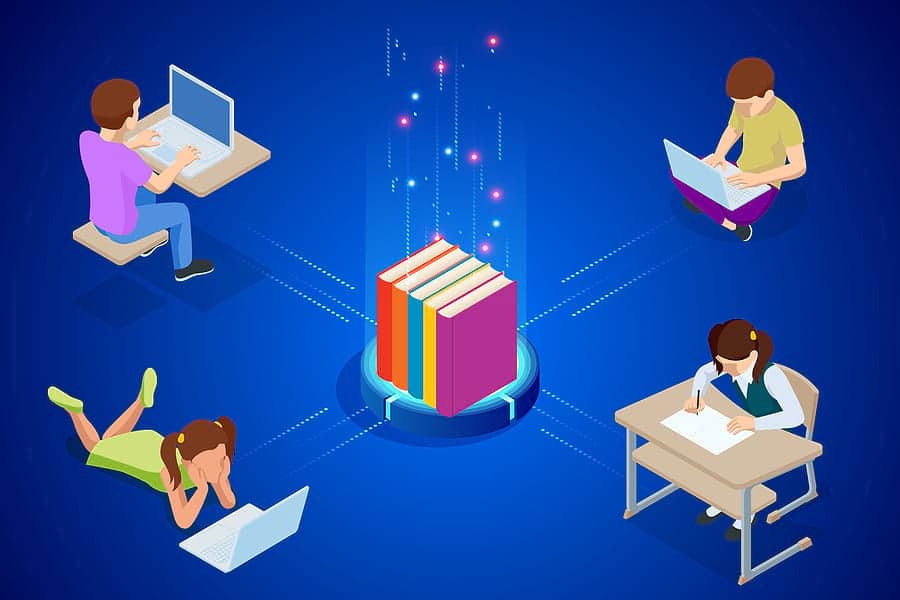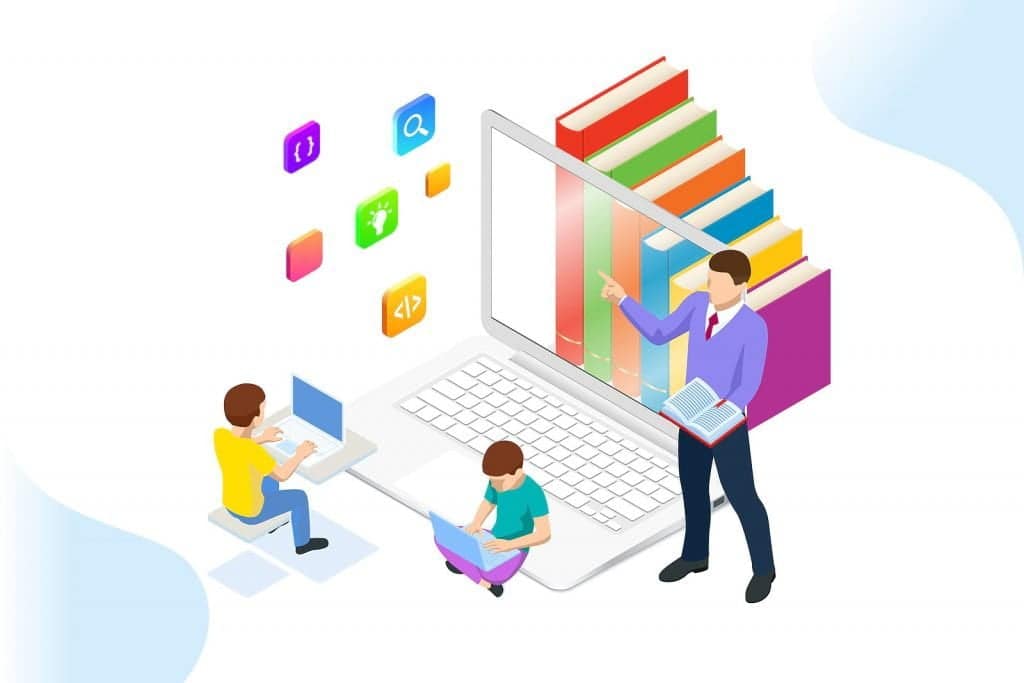How do we use AI in education today?
In broad terms, AI or artificial intelligence is an attempt to create machines that can do things previously possible only through human perception, learning, or reasoning. While many researchers’ ultimate goal is to develop AI capable of equaling and exceeding the full range of human cognition (a level known as artificial general intelligence, or AGI), we’re probably still several decades away from such technology.
For the moment, artificial intelligence is narrow or weak, consisting of machines and systems with task-specific programming. Initially, so-called “expert systems” were developed by extensive programming rules into computers. More recently, however, AI has been advancing through the use of machine learning or ML — the observation and gathering of reams of data, identifying correlations that would not be immediately comprehensible to humans, and the use of those patterns to make decisions.
Artificial Intelligence in Education
This machine learning process has direct correlations to how humans learn. It should come as no surprise that these advances in technology are fueling the use of artificial intelligence in education.
With numerous stakeholders involved, there are plenty of avenues available for the use of artificial intelligence in education, and the market currently offers solutions for adults, children, tutors, and educational establishments. AI-based systems can analyze an enormous amount of information, and the application of artificial intelligence in education covers a range that includes training, communications, administration, and resource management.
How is Artificial Intelligence Used in Education?
For the most part, applications of artificial intelligence and machine learning in education take a virtual form, rather than being embodied like robots. There may be physical components involved, such as audio or visual sensors of the Internet of Things (IoT) that collect or observe environmental information. But artificial intelligence in education system applications generally manifests via digital software processing systems. This manifestation plays roles in education at various levels, including:
AI in Education: Developing Smart Content
AI systems can use the materials of a traditional syllabus to create customized textbooks for certain subjects. Such systems digitize this course material and create new learning interfaces to help students of all academic grades and ages.
Creating Personalized Learning Experiences
There’s a quote by Albert Einstein, which says that “Everybody is a genius, but if you judge a fish by its ability to climb a tree, it will live its whole life believing that it is stupid.” No two students are the same, or learn in exactly the same way.
By providing customizable tutoring and studying support applications, AI can adapt educational frameworks to cater to individuals’ needs according to their abilities, interests, and aptitude.
AI in Education: Expanding the Range of Education
In general, AI and digital technology are helping to eliminate boundaries and extend educational opportunities to learners throughout the world. Intelligent web search and recommendation engines can provide students with the information and resources they need to further their education. And platforms like the Massive Open Online Course or MOOC are making courses instantly accessible to anyone with an internet connection. This is one of the significant benefits of artificial intelligence in education.
Facilitating Education Management and Administration
An education management information system or EMIS is an integrated group of information and documentation services to collect, store, process, analyze, and disseminate data for educational planning and management.
With the advancement of digital and machine learning technologies, these platforms are evolving into intelligent learning management systems (LMSs). From the masses of data collected through an EMIS, AI and machine learning algorithms can make data-driven decisions to improve school administration and education delivery.
AI in Education: Intelligent Tutoring and Learning
Intelligent tutoring system (ITS) and intelligent learning system (ILS) technologies provide AI-powered digital platforms that enable students to discover information for themselves. As well as acting as a medium for guided learning, they can also perform extensive diagnostics on student performance, maintaining a continuous model of their knowledge, skills, errors, and misconceptions — and providing recommendations or solutions to steer them along the path to progress.
10 Roles for Artificial Intelligence in Education
Artificial or machine intelligence can help students and teachers get more out of the educational experience by assuming a number of roles, including:
- Automating Basic or Repetitive Activities: AI can currently automate grading for nearly all kinds of multiple-choice and fill-in-the-blank testing. As essay-grading software continues to evolve, this range of capabilities will expand.
- Providing Personalized Learning Platforms: The growing numbers of adaptive learning programs, games, and software use AI to respond to the needs of individual students, laying greater emphasis on certain subjects, repeating things that students haven’t mastered, and generally helping them to work at their own pace.
- Identifying Gaps and Failings in the Curriculum: Systems like the electronic learning (eLearning) platform Coursera can give alerts if a large number of students submit the wrong answer to a homework assignment or have trouble with a particular topic.
- Virtual Tutors: AI-powered tutoring systems are already helping students through basic mathematics, writing, and other subjects.
- As a Feedback Loop for Students and Instructors: AI systems can monitor student progress and alert professors when there might issues.
- Providing New Ways to Interact with Information: As technologies evolve and integrate, students in the future may have increasingly immersive and diverse experiences doing research.
- Creating a New Dynamic with Teachers: As AI becomes more integrated with the education system, teachers may supplement AI lessons, assisting students who are struggling, and providing human interaction and in-person experiences.
- Reducing Academic and Social Pressures: With AI systems themselves often based on trial and error, they can facilitate this kind of learning in an environment where students don’t feel pressured to compare themselves with their colleagues.
- Providing New Avenues for Recruitment, Teaching, and Support: Smart data gathering powered by intelligent computer systems can provide information and recommendations to enhance students’ lives and the operations of educational institutions.
- Changing the Dynamics of Learning: AI systems, software, and support, coupled with internet connectivity, enables students to learn from anywhere in the world at any time.
Artificial Intelligence in Higher Education: Current uses and Future Applications
With high stakes riding on the outcomes of higher education — job prospects, funding for institutions, implications for the wider economy — there’s a particular interest in acquiring the best tools, technologies, and talent to assure the success of establishments of higher learning. In this regard, artificial intelligence in higher education is contributing in a number of ways.
For recruiting and enrollment, some colleges and universities are using complex analytics systems based on machine learning that can calculate an individual’s “demonstrated interest” in a particular course of study by tracking their interactions with institutional websites, social media posts, and email messages.
Enrollment analytics platforms can assist schools in determining which students they should reach out to, which aspects of campus life they should emphasize, and in the assessment of admissions applications.
Machine learning algorithms are also assisting higher education establishments in their marketing to prospective students, estimation of class sizes, the planning of the curriculum, and the allocation of resources.

For students, machine learning applications and platforms are helping to provide a number of support services. For example, some applications help students automatically schedule their course load, while others recommend courses, majors, and career paths. The tools can make recommendations based on how students with similar data profiles performed in the past.
AI software systems can use highly granular patterns of information and accurate assessments of student behavior. This analysis can help identify students who may be at risk — academically, socially, or financially. Institutions can use the information for determining which students merit financial aid or other interventions. However, these systems can raise concerns about individual privacy and autonomy.
From day to day, AI-based educational software can provide a personalized learning platform, with continuous and real-time assessments of student performance, and proactive recommendations of specific parts of a course for students to review, or additional resources for them to consult.
A striking instance of the use of artificial intelligence in science education comes from the annals of the Georgia Institute of Technology (Georgia Tech), where many of the students in a master’ s-level AI class were unaware that one of their teaching assistants (Jill Watson) wasn’t human.
Jill was actually a digital entity, programmed to respond to a set of commonly repeated queries, and posted as one of the message board members. With a memory populated by tens of thousands of questions and answers from past semesters, Jill was one of the most effective teaching assistants the class had ever seen, answering questions with a success rate of 97 percent.
Looking ahead, higher institutions will face several challenges in their implementation and use of AI, as the technology evolves. Not least among these is the financial cost and the time that human workers will have to spend in training and curating data for advanced systems. Training will also be required for staff outside of IT teams who must be brought up to speed in the use of data and AI tools.
Other Artificial Intelligence Benefits in Education
Besides the advantages of using AI in education that we have already observed, there are other benefits, including:
- Continuous Access to Learning: With much of the AI technology-based online, education becomes an “anywhere, anytime” process, which may be undertaken more at the student’s convenience.
- Access for Students with Special Needs: Innovative AI technologies are providing new ways of interacting for students with learning or physical disabilities and special needs.
- Increased Engagement: Personalized learning platforms with individualized course work, schedules, customized tasks, and interaction with digital technologies increase student engagement with the learning process, promoting retention and improved performance.
- Reduced Academic / Social Pressure: Material tailored to the needs of different learning groups enables students to proceed with their education without continually comparing themselves to others.
AI in Education: Some Potential Pitfalls
Of course, the use of AI in education isn’t without complications and risks. Most notably:
- AI May Create Its Own Value System: By selecting the variables fed into admission, financial aid, or student information systems, AI tools are effectively creating rules about what matters in higher education. These criteria may not be the ideal ones.
- Institutions May Lose Sight or Control of Their Data: AI and ML systems rely on data management — and this is often contracted out to private companies that may be less directly accountable to the educational institution’s stakeholders.
- Reliance on Data Risks Missing Out on Human Perception: Systems reliant on data and narrowly defined goals may miss the nuances and perceptions that would be seen by a human.
- There May be Conflicts of Interest: Predictive analytics and early warning systems can promote student retention by drawing attention to those struggling. But they can also provide less benevolent institutions with ammunition for down-sizing their student populations.
Summary:
AI in Education
This machine learning process has direct correlations to how humans learn. It should come as no surprise that these advances in technology are fueling the use of artificial intelligence in education. With numerous stakeholders involved, there are plenty of avenues available for the use of artificial intelligence in education, and the market currently offers solutions for adults, children, tutors, and educational establishments. AI-based systems can analyze an enormous amount of information, and the application of artificial intelligence in education covers a range that includes training, communications, administration, and resource management.

